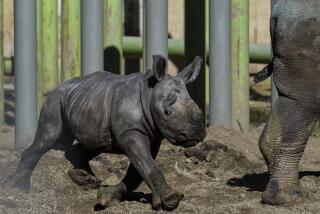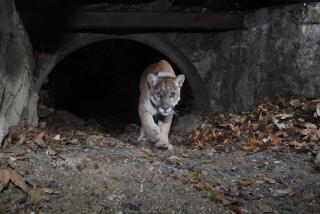Kenya Sanctuary Allows Black Rhinos to Build Up Population : Wildlife: Two decades of poachers and disease have cut the breed’s numbers to 352. A bold conservation project aims to save the remaining few.
- Share via
LAKE NAKURU NATIONAL PARK, Kenya — She’s an enormous beast, moving like the ghost of a battle tank through the woods that cover the cliff side. Sporting a horn as long as a man’s arm, she’s the oldest rhinoceros in Kenya’s Lake Nakuru National Park.
She was spotted an hour after dawn, climbing steadily and easily, an incongruous moving boulder high up among the scrub as a low sun lit the hillside clear red under the sky’s crisp blue. There was near silence in the valley: a vervet monkey’s call, a hidden bird’s hoot reverberating off the cliffs. The rhinoceros paused to browse on the shoots of an acacia thorn, looked up, hoisted her horn, and was gone into the thicket as silently as she had come.
“It’ll be the old girl,” said Jock Dawson, who runs a rhinoceros sanctuary at the park. “I’m afraid she’s gone to sleep up there somewhere.”
For all their size, the black rhinos of east Africa are elusive beasts. Wood-dwellers, unlike the grass-grazing white rhino, they make hardly a sound, can run at 30 to 40 m.p.h., and do a fair imitation of a weathered old gray rock.
They have had 70 million years in which to practice not being seen. The old lady of Nakuru is the descendant of about 14 million rhinos like her. But as the world has come to know, most of those ancestors didn’t practice hard enough.
They didn’t really need to until a rather puny ape came along and started pumping high-velocity, high-caliber shells through that thick gray hide, hacking out the horn and turning it into dagger handles and medicines. Until then, the rhinoceros simply had no enemies.
There were 22,000 black rhinos in Kenya in 1970. After two decades in which poachers armed with machine guns went after the prized horns, there are 352 left.
If the wardens at Nakuru are right, there will soon be 354.
For the 18 adult rhinos in the lakeside park, 90 miles northwest of Nairobi, have been breeding. It’s a minor triumph.
Set up only three years ago, the Rhino Sanctuary at Nakuru is a brave experiment in wildlife conservation. It was the brainchild of a group of former white hunters in London, who in 1986 launched an appeal for funds in the upper chamber of Britain’s Parliament, the House of Lords.
They struck a nerve. In a remarkably short space of time, money came rolling in. The group, based in the United Kingdom and now known as the Rhino Rescue Trust, picked their site.
They set about erecting 45 miles of double fence--one chain-link, one 5,000-volt electrified--around the park, until then famed only for its million or so flamingos, which live like pink clouds along the shores of Lake Nakuru.
RRT had two rhinos already inside the secure area. They got 15 more from American conservationist Courtland Parfet, whose private ranch near Mt. Kenya had pioneered the concept of the fenced sanctuary. The group got two more from other parks in Kenya, but were compelled by inter-rhinoceros rivalry to give one away.
The trust’s operation at Nakuru has been run for the past two years by Dawson, a former hunter with white hair, blue-gray eyes, metal-framed glasses and old brown knees such as befit a man who has made a life from the wild. Though he has lived all his life in Kenya, he still holds up his socks with the red-flashed garters of his kilt-wearing Scots forebears.
And he knows a great deal about rhinos.
His family came to Africa in 1888, before the British had even declared the Kenyan protectorate. A great-uncle was killed by Masai warriors in 1895. Jock himself was born not long after World War I.
He was a professional hunter until 1977, and has been an honorary game warden since 1961.
“The game warden bit is useful,” he says, with a friendly gleam in his eye. “If I catch a chap poaching in the park, I can shoot him.”
And he would, too. For all his dry Scots understatement, Dawson cares a great deal about the animals in his charge. He has two enormous Abyssinian eagle owls with broken wings in a tree-size wire enclosure by his cottage, admits to stroking buffalo and talks with fondness of the leopard that saunters past the side of the house every evening at gin-and-tonic time.
But the rhinos are his job.
“The first baby was sighted on Boxing Day (Dec. 26), 1988,” he says. “The second one came along on Jan. 10 this year. She was maybe 3 weeks or a month old.”
What’s more, he says, two more of Nakuru’s six females may be pregnant now.
“We know they have been served,” he chuckles. “Whether they’re pregnant or not is another matter.”
Even the old lady may still be of breeding age.
“She certainly has an enormous belly on her,” Dawson says.
With a calving interval of 32 to 36 months and five, maybe six, cows of breeding age, Nakuru is potentially on track to doubling its rhino population within 10 to 15 years.
There is room, says Dawson, for 60 or 70 in the park.
All this sounds like very good news for the black rhino. There are many who believe that the tide has turned and that sanctuaries like Nakuru can be used to restock the plains and forests of east Africa, putting rhinos back where they used to be.
But Dawson has a bleaker vision.
“There’s a lot of talk about that sort of thing,” he says. “But if you look at the human population of this country, then there isn’t room for the rhinos. The population here has gone from 5 million a few years back to 30 million today. Sixty-five percent of the people are under 20 years old. It doesn’t bear thinking about what will happen in the next 20 years.
“Then there’s the disease factor. People think the only thing that can harm these rhinos are poachers. The poaching goes on, of course, but the rhinos here for example have no natural immunity to tsetse fly,” he says.
To release black rhinos into areas like southwest Kenya inhabited by the lethal tsetse fly, which carries the “sleeping sickness” trypanosome parasite, would require a hugely expensive acclimatization program, Dawson points out.
Lastly, there are the poachers who won’t go away.
Nakuru has yet to lose a rhino to poaching, but Dawson fears the less dramatic wire snares of the local gazelle poacher supplementing the family pot more than he does the machine-gun toter.
” . . . I had to shoot a buffalo who’d been caught in one. His whole hoof was off, and he was walking on a bare stump,” he recalls. “Everyone knows how to get through the electric fence.”
On the wall of his office in the park, Dawson has a hand-drawn map with pins stuck in it--red and blue for the rhino, green for the sole pride of lions.
One supposes those are the animals’ last known positions.
Dawson smiles his canny Scots smile.
“That’s what you’re supposed to think,” he says. “They’re not really in those places at all.”
And if he has his way, even in the limited space of Nakuru, they will remain not there for many years to come.
More to Read
Sign up for Essential California
The most important California stories and recommendations in your inbox every morning.
You may occasionally receive promotional content from the Los Angeles Times.













